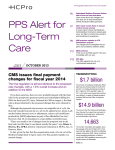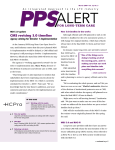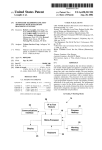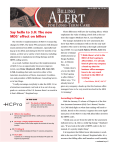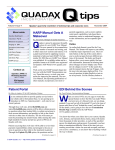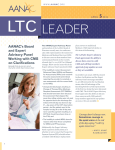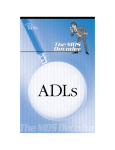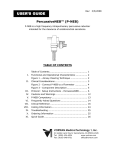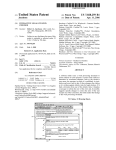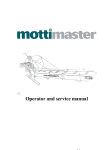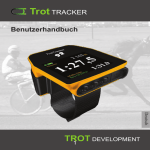Download PPS payment update provides a slight increase, but few
Transcript
October 2012 Vol. 15, No. 10 PPS payment update provides a slight increase, but few changes significant increase from last year’s 11.1% Medicare reduction. The overall market basket increase is 2.5% for SNFs, but a 0.7% adjustment as part of the Affordable Care Act’s 10-year plan to reduce Medicare knocks down the overall increase. CMS estimates this will translate to an influx of approximately $670 million. After reading this article, you will be able to: ➤➤ Identify the changes made by CMS to the SNF PPS for fi scal year 2013 ➤➤ Describe the impact these changes may have on a facility’s coding and billing practices ➤➤ Describe the impact these changes may have on a facility’s documentation practices Also of note, CMS decided to forgo the usual rulemaking process by skipping the comment period and simply is- that there is an increase. suing the final rule in We never thought there July. In April, CMS would be one. Even announced that rather though it’s small, I think than proposing new that’s positive.” regulations that could There is a saying that goes “Something is better than “The positive thing is —Bonnie G. Foster, radically affect pay- RN, BSN, M.Ed. nothing,” which is the mantra SNFs should have for the ments, it would simply 2013 fiscal year. make statutory update adjustments to Medicare Part A, In July, CMS officially released an update notice regarding the SNF PPS for fiscal year 2013. CMS has issued a 1.8% increase to the market basket rate, a enabling it to forgo the comment period. Although it’s a fairly insignificant increase, SNFs should be relieved that it’s not another year of drastic cuts, says Bonnie G. Foster, RN, BSN, M.Ed., owner and presi- IN THIS ISSUE p. 4 ICD-10 postponed until 2014 On August 24, HHS issued the final ruling, confirming a one-year extension of the ICD-10 compliance deadline. Find out what this means for your facility. dent at Foster Consulting, Inc., in Columbia, S.C. “The positive thing is that there is an increase,” Foster says. “We never thought there would be one. Even though it’s small, I think that’s positive.” On the other hand, the slight increase reinforces the importance for facilities to focus on the accuracy of their p. 7CMS’ Nursing Home Action Plan focuses on quality and patient care Learn more about CMS’ 2012 Nursing Home Action Plan, which supports the three-part directive from the national organization to improve healthcare in the United States. p. 10 MDS professor Think you’re an MDS expert? Test your knowledge of this long-term care assessment tool with our quiz. p. 11 PPS Q&A Regulatory specialist Diane L. Brown, BA, CPRA, discusses significant change criteria, coding for IV fluids, and requirements for EOT OMRAs. coding and Medicare billing, as well as how patients are receiving therapy, an issue that CMS has been monitoring closely. Watch your RUG rates Ever since the Office of Inspector General (OIG) released the report Questionable Billing by Skilled Nursing Facilities in December 2010, CMS has been more actively involved in cracking down on facilities PPS Alert for Long-Term Care Page 2 October 2012 that may be getting inflated reimbursement. Looking executive vice president of reimbursement for at data from 2006 to 2008, the report found that SNFs Paramount Health Care Company in Garden Ridge, increasingly billed Medicare for higher-paying RUG Texas. rates, even though patient characteristics remained With only a small increase to Medicare payments, largely the same. The report found that payments to SNFs may be tempted to find more revenue with RUGs, SNFs with ultra-high therapy RUGs increased 90% particularly involving therapy, but they should be very during that time period, accounting for a $5 billion cautious in how those services are billed, Foster says. increase in payments. In fact, many elderly patients may be too ill to do As a result, OIG recommended that CMS monitor payments from SNFs, particularly those that are billing for higher-paying RUGs, and change the current method therapy, especially when they are first admitted to a SNF, and their care plan needs to reflect that. “That has always been the concern of therapists,” for determining how much therapy is needed to ensure Foster says. “Our residents are sicker than they have appropriate payments. ever been and the idea of taking someone who is 80 “CMS has been closely monitoring the amount of years old with a fractured hip to therapy—especially if individual, concurrent, and group therapy, so providers they also have diabetes or congestive heart failure or de- obviously need to provide what is most appropriate for mentia—taking them to therapy with the idea of getting the resident,” says Julia Hopp, MS, RN, NEA-BC, a very high or ultra-high RUG is just not realistic.” Instead, SNFs should focus their attention on provid- Editorial Advisory Board PPS Alert for Long-Term Care Assoc. Editorial Director: Elizabeth Petersen Associate Editor: Melissa D’Amico, [email protected] Contributing Editor: Evan Sweeney ing a complete and individualized care plan. For example, a younger patient who has just had a knee replacement and is only going to be in the facility for two to three weeks should receive as much therapy as possible. An older patient with multiple health issues may require Diane L. Brown, BA, CPRA Regulatory Specialist and Boot Camp Instructor HCPro, Inc. Danvers, Mass. Mary C. Malone, JD Healthcare Attorney, Director Hancock, Daniel, Johnson & Nagle, PC Richmond, Va. less therapy, or more focused therapy. Sandra Fitzler Senior Director of Clinical Services American Health Care Association Washington, D.C. Maureen McCarthy, RN, BS, CPRA Director of Medicare Regulatory Compliance and Education National Healthcare Associates Goshen, Conn. providing the type of care that the residents need and Bonnie G. Foster, RN, BSN, M.Ed. Long-Term Care Consultant Columbia, S.C. Cindy Frakes Owner Winter Meadow Homes, Inc. Topeka, Kan. Julia Hopp, MS, RN, NEA-BC Executive Vice President of Reimbursement Paramount Health Care Company Garden Ridge, Texas Steven B. Littlehale, MS, GCNS-BC Executive Vice President, Healthcare Chief Clinical Officer PointRight, Inc. Lexington, Mass. Frosini Rubertino, RN, CPRA, CDONA/LTC Executive Director Training in Motion, LLC Bella Vista, Ark. Rena R. Shephard, MHA, RN, RAC-MT, C-NE President RRS Healthcare Consulting Services San Diego, Calif. Holly F. Sox, RN, BSN, RAC-CT MDS Coordinator Presbyterian Communities of South Carolina Lexington, S.C. PPS Alert for Long-Term Care (ISSN: 1521-4990 [print]; 1937-7428 [online]) is published monthly by HCPro, Inc., 75 Sylvan St., Suite A-101, Danvers, MA 01923. Subscription rate: $239/year. • PPS Alert for Long-Term Care, P.O. Box 3049, Peabody, MA 01961-3049. • Copyright © 2012 HCPro, Inc. • All rights reserved. Printed in the USA. Except where specifically encouraged, no part of this publication may be reproduced, in any form or by any means, without prior written consent of HCPro, Inc., or the Copyright Clearance Center at 978-750-8400. Please notify us immediately if you have received an unauthorized copy. • For editorial comments or questions, call 781-639-1872 or fax 781-639-7857. For renewal or subscription information, call customer service at 800-650-6787, fax 800-639-8511, or email [email protected]. • Visit our website at www.hcpro.com. • Occasionally, we make our subscriber list available to selected companies/vendors. If you do not wish to be included on this mailing list, please write to the marketing department at the address above. • Opinions expressed are not necessarily those of PPSA. Mention of products and services does not constitute endorsement. Advice given is general, and readers should consult professional counsel for specific legal, ethical, or clinical questions. © 2012 HCPro, Inc. “What you really need to work on is that you’re also that you are reimbursed for the care that you’re providing,” Hopp says. In many SNFs there is a struggle between the patient’s schedule and the therapist’s schedule. Therapists want to start at 8 a.m., but patients often want to sleep in, take a shower, and have breakfast before going to therapy. With more focus on resident satisfaction, says Questions? Comments? Ideas? Contact Associate Editor Melissa D’Amico Telephone 781-639-1872, Ext. 3505 Email [email protected] For permission to reproduce part or all of this newsletter for external distribution or use in educational packets, contact the Copyright Clearance Center at www.copyright.com or 978-750-8400. PPS Alert for Long-Term Care October 2012 Page 3 Foster, the SNF will have to find ways to work around billing and coding documentation, which is the back- both schedules. bone of a CMS audit. To resolve these issues, it’s imperative that thera- “SNFs need to be monitoring the care that they are pists are included in the care plan process, Foster says. providing and making sure they are coding that care With this approach, therapists can communicate with accurately, and triple-checking the billing with the MDS the doctors and nurses to determine what other health to make sure everything matches up correctly,” Hopp complications the patient is dealing with and they can says. “Providers really just need to continue doing what push for restorative therapy programs so there is some they have been doing, but just make sure everything is continuity between what the therapist is doing and what as accurate as possible.” the clinicians are doing. In some facilities, therapists operate in their own Audits can be extremely nerve-racking for a facility, and the results can be equally detrimental, Foster says. bubble, which can cause confusion with nurses and Even the slightest discrepancy can affect reimbursement nursing assistants. rates, particularly when it comes to therapy and RUGs. “They are a really big part of the team,” Foster says. “I don’t think I’ve ever been through an audit where “With this team approach the patient might actually a facility didn’t have to pay back some money, and need more therapy. There are solutions, but they have to we’re talking thousands and thousands of dollars,” be part of the team.” Foster says. This confusion can also create discrepancies between However SNFs can minimize that damage by the patient chart and billing and MDS forms. For example, reinforcing a team-centered approach to patient care, an occupational therapist might be working with a patient and training clinicians and coders on the effects of to teach the patient to dress him- or herself, but in the improper documentation. nursing documentation the nurse would note that the “The problem is that it’s usually very simple stuff; patient dressed him- or herself, leading a Medicare auditor stuff you don’t even think about,” Foster says. “But once to question why the occupational therapist is getting paid you’ve been audited you’re on their list, and then you’re to teach the patient what he or she already knows how to always on their list.” n do. If the therapist were included in a meeting with the nurse, that detail could have been resolved. “That could be a major monetary payback,” Foster says. “You can’t do anything about that because it’s already charted. You can’t go back and erase it or change it.” Gain QM confidence with our upcoming webcast Quality measures (QM) are back! The blackout period is now over and there are updates you need on Triple-check your documentation Many facilities are likely still feeling the impact of regulations pertaining to the use of the QMs and the three QM reports that surveyors issue to providers. During this 90-minute broadcast, our expert speaker last year’s Medicare cuts, as well as the Medicaid rates will identify the triggering criteria, high-risk areas, how that were either cut or maintained at the state level. MDS-driven QMs are calculated, and the impact of the These payment decreases have only highlighted the threshold comparison adjustment. need for accuracy so SNFs are fairly compensated for the care they provide. During a time of increased scrutiny from CMS regarding overpayment and Medicare For more information about this webcast, visit HCPro at www.hcmarketplace.com/prod-10503. fraud, SNFs need to be particularly aware of their © 2012 HCPro, Inc. For permission to reproduce part or all of this newsletter for external distribution or use in educational packets, contact the Copyright Clearance Center at www.copyright.com or 978-750-8400. PPS Alert for Long-Term Care Page 4 October 2012 ICD-10 postponed until 2014, giving facilities another year to prepare indicated they would not be ready for the ICD-10 After reading this article, you will be able to: ➤➤ State the new compliance deadline for ICD-10, as established by HHS ➤➤ Discuss the reasons why HHS initiated a proposal for the ICD-10 compliance deadline delay ➤➤ Describe steps that facilities should take to prepare and implement a successful ICD-10 transition In April, the U.S. Department of Health and H uman Services (HHS) proposed an extension of the ICD-10 deadline for one year, from October 1, 2013, to October 1, 2013, deadline. Another survey conducted by the American Health Information Management Association in September 2011 had mixed results from 639 providers concerning compliance efforts with Version 5010 and ICD-10. Although 85% of inpatient facilities had begun preparing for the implementation of ICD-10, 39.3% of all other providers had not started planning at all. Furthermore, of the “other” providers that hadn’t started implementation planning, 50.5% indicated they weren’t sure when this planning would begin. Lastly, according to a survey by the Workgroup for October 1, 2014. On August 24, HHS issued the final Electronic Data Interchange conducted in February, ruling, confirming the one-year extension, which was 50% of respondents indicated they didn’t know when instituted to allow more time for healthcare facilities— they would complete their impact assessment of the particularly smaller facilities—to adopt the new coding ICD-10 transition. system. Even after the January deadline for Version 5010, “We believe the change in the compliance date for healthcare organizations—particularly smaller ICD-10 gives covered health care providers and other organizations—continued to struggle. In February, the covered entities more time to prepare and fully test Medical Group Management Association sent a letter to their systems to ensure a smooth and coordinated HHS indicating that if the government didn’t step in to transition by all covered entities,” HHS said in the final help solve the problems with transitioning to 5010, phy- published ruling. sician practices would face operational difficulties and Many facilities expressed concern with the 2013 could even be forced to close their practices. Given the deadline, pointing to the difficulty a variety of organiza- struggles the healthcare industry had with Version 5010, tions had in meeting the compliance deadline for the there were plenty of concerns among long-term care Associated Standard Committee’s X12 Version 5010 providers that implementing an even more complicated standards, which updated billing software and laid the system in ICD-10 would be extremely difficult by the groundwork to accommodate the longer and more de- October 2013 deadline, says Dawn Duchek, industry tailed ICD-10 coding system. initiatives coordinator for Gateway EDI in St. Louis. In December 2011, CMS conducted a survey among “5010 had a much bigger impact to the industry than 404 healthcare providers, 101 payers, and 90 vendors to was expected,” Duchek says. “The goal with ICD-10 is to determine how well prepared the industry was for these have a much smoother transition and to better prepare changes. CMS found that 83% of providers were aware for the potential bumps in the road.” of the upgrade to Version 5010, but only 64% indicated From a financial perspective, a regulatory impact they would be compliant by the January 2012 deadline. analysis conducted by HHS showed a cost avoidance of Additionally, nearly a quarter of providers in the survey $3.6–$8 billion that would incur if healthcare providers © 2012 HCPro, Inc. For permission to reproduce part or all of this newsletter for external distribution or use in educational packets, contact the Copyright Clearance Center at www.copyright.com or 978-750-8400. PPS Alert for Long-Term Care October 2012 Page 5 and plans had to process claims manually, and smaller also be able to better handle the transition to electronic healthcare providers would have to take out loans as a medical records (EMR) by providing more current result of delayed payments. information on a resident’s condition, and staying current with terminology and clinical concepts. A new date with the same changes Although the transition to ICD-10 is on the horizon, Aside from the date, nothing has changed in terms facilities still need help fully understanding the current of the impact of the transition from ICD-9-CM to ICD- ICD-9 system, says Marilyn Mines, senior manager of 10-CM. These new diagnosis codes are still much more clinical services for FR&R Healthcare Consulting, Inc., in specific than the ICD-9 version. ICD-9 codes are three to Deerfield, Ill. These misconceptions will only make the five characters, whereas ICD-10 codes are three to seven transition more difficult. characters and alphanumeric, offering more detail and “There’s a lot involved in ICD-10 that is not under- specificity for certain conditions. For example, under stood,” she says. “I’m not sure how SNFs are going to be ICD-9, pressure ulcers were coded as 707.0x and 702.2x able to move to the specificity of this coding when the in order to define the scope and stage. ICD-10 gets far current coding is not always being done correctly.” more specific with more than 100 codes for pressure ulcers that define the location, laterality, and stage of the wound. Approaching the change The following are suggested steps facilities can take to Once implemented, the specificity of ICD-10-CM coding will paint a fuller and more detailed picture of facilitate a smooth transition to ICD-10: ➤➤ Assemble a steering committee. The first step in the resident in the UB-04 form, which should ultimately making the transition to ICD-10-CM is to assemble reduce the number of denials to SNFs. The system will a steering committee made up of representatives Advisory Services Customized guidance from a trusted source. The demands on long-term care providers have never been greater. HCPro’s Advisory Services are outcome-driven, individualized solutions to meet your most complex regulatory, financial, and operational challenges. Our value lies in the unique partnership we build with providers and the results we help them achieve. There is nothing standardized about our approach—we will evaluate your current processes and outcomes, create action plans to improve them, build tools to use in practice, and implement a system for sustainable results. Our team of advisors offers a full range of services to long-term care providers, including: • Documentation Improvement Review • Survey Preparation and Response • Case Mix Analysis • MDS 3.0 & RUG-IV Review • Compliance Program Development • Medicare Coding and Billing Audits To discuss your needs with lead advisor Diane Brown, please call 877-233-8828 for a free, no-obligation conversation about how HCPro Advisory Services can benefit you today. www.hcpro.com/LTCadvisory MC104363B - 0112 © 2012 HCPro, Inc. For permission to reproduce part or all of this newsletter for external distribution or use in educational packets, contact the Copyright Clearance Center at www.copyright.com or 978-750-8400. PPS Alert for Long-Term Care Page 6 October 2012 from coding, billing, and IT, as well as doctors “fractured hip.” A similar situation arises with pres- and nurses who can help with the specific clinical sure ulcers as they progress or regress to higher or translations, Duchek says. This committee should lower stages. Facilities need to develop written poli- look at ways the new system will affect software, cies that dictate an effective flow of information to hardware storage, and paper processes, how patients input diagnostic changes as they arise. “This includes will be impacted, and where their facility is in terms new diagnoses as they come up,” Mines says. “The of making this switch. billers need to have a point person who is knowl- ➤➤ Identify software needs. Software upgrades may edgeable, that they can consult with in updating, be necessary to house the additional 140,000 codes changing, and eliminating diagnoses and conditions. included in ICD-10, as well as the existing ICD-9 The same diagnoses from the hospital stay should not codes which will continue to be used for inpatients continue from 10 years earlier if they are resolved.” with a discharge date prior to October 1, 2014, or if there is an issue with rebilling. “Now is the time to look at the reports you’re getting from your practice Start sooner rather than later “Pushing the ICD-10 back to 2014 shouldn’t translate management system or EMR to identify the ICD-9 to an extra year of procrastination,” Duchek says. codes you use most often,” Duchek says. “Identifying Facilities should be using this additional time to begin your top revenue codes is a good place to start with the process of evaluating how they will make the mapping ICD-9 to ICD-10. You will also want to con- transition. firm that your ICD-9 reports will be converted to “We had the interim final rule in February and now six months have gone by, so if you haven’t done ICD-10.” ➤➤ Establish a lead contact within the facility. anything, what have you gained? You’ve only gained six Facilities should also appoint a designated point per- months,” Duchek says. “The longer you procrastinate, son that is going to be the resident expert in the new the less time you have to get ready. There are so many system and lead the transition. MDS coordinators things that a facility or practice can do today that can are typically the ones who handle the current ICD-9 help them with the processes right now and help them system, so the responsibility will most likely fall to to understand the impacts of ICD-10.” them, although a team approach may be necessary, Mines recommends initiating a task force at the Mines says. “With the new system, there might be beginning of 2013 to get the process started by identi- the need to have an actual coder who is more edu- fying a few key leaders to look at how new codes will cated in the system, one who can be more accurate,” be implemented and how they will affect the facil- she says. “But I’m fearful that it is all going to fall to ity’s current billing system. This committee should also the MDS coordinators.” look at their percentage of rejections and appeals with ➤➤ Examine internal processes. Long-term care ICD-9, whether those will increase or decrease with facilities in particular should also focus on their pro- ICD-10, and how they can maximize reimbursement by cess for changing a resident’s diagnosis, Mines says. accurately applying the new system. The specificity of ICD-10 coding will allow for more “I would say right after the beginning of the year timely adjustments as new issues arise or an existing is when people should sit down with their teams and diagnosis is resolved. For example, residents often figure out what they’re going to do and set up a sched- come into a long-term care facility after having sur- ule of events, so when the date actually comes they gery for a fractured hip in the hospital. Even though won’t be out of their minds to figure out what to do,” it has been resolved, their diagnosis still reads, Mines says. n © 2012 HCPro, Inc. For permission to reproduce part or all of this newsletter for external distribution or use in educational packets, contact the Copyright Clearance Center at www.copyright.com or 978-750-8400. PPS Alert for Long-Term Care October 2012 Page 7 CMS’ Nursing Home Action Plan focuses on quality and patient care attempts to prevent costly rehospitalizations through After reading this article, you will be able to: ➤➤ State the main objective of CMS’ 2012 Nursing Home Action Plan ➤➤ Describe the five approaches CMS suggests nursing homes should take to meet the plan’s objectives ➤➤ Recognize the impact these objectives have on maintaining quality of care for nursing home residents CMS has released its 2012 Nursing Home Action Plan, which supports the three-part directive from the national organization to improve healthcare in the United States. The three objectives are: ➤➤ Improving the individual experience of care ➤➤ Improving the health of populations ➤➤ Reducing the per capita cost of care for populations In an attempt to meet these three overall objectives, CMS has laid out five approaches for nursing homes to consider going into next year: ➤➤ Enhance customer engagement with relevant, timely information that can be accessed by the public ➤➤ Strengthen survey processes, standards, and enforce- high-quality care Aside from these direct objectives, the 2012 plan gives nursing homes and SNFs a broad idea as to what CMS surveyors will be focusing on and the direction they should take their facility to maximize their reimbursement. Quality matters Quality care and performance has been and continues to be a recurring theme, which means facilities should continue to pay particular attention to the quality measures released by CMS, says Janet Potter, CPA, MAS, manager of healthcare research at FR&R Healthcare Consulting, Inc., in Deerfield, Ill. “Long-term care facilities have had the stigma of Document resident care with ease! Long-Term Care Clinical Assessment and Documentation Cheat Sheets is the ultimate blueprint for how to provide resident-centered care for any symptom or condition. Available on CD, this electronic-only resource provides ment by improving the way data is captured and im- nurses with a thorough list of what to check and what proving the consistency with which nursing homes to document during every shift based on the specific are regulated circumstances of a given resident. ➤➤ Promote quality improvement by reducing physical restraints, rehospitalizations, and the prevalence of pressure ulcers, as well as supporting institutional culture change ➤➤ Create strategic approaches through partnerships with the U.S. Department of Health and Human Services, Quality Improvement Organizations, and state survey agencies ➤➤ Advance quality through innovation and demonstration with projects such as the Nursing Home Best of all, the new electronic format of this content enables long-term care clinicians to easily search for the condition they need to treat and access the appropriate checklist within seconds. Each checklist can be downloaded and printed to fit directly into the resident’s record to ensure thorough, focused, and regular assessments and documentation for every resident. For more information about this product, visit HCPro at www.hcmarketplace.com/prod-9750. Value-Based Purchasing Demonstration, which © 2012 HCPro, Inc. For permission to reproduce part or all of this newsletter for external distribution or use in educational packets, contact the Copyright Clearance Center at www.copyright.com or 978-750-8400. PPS Alert for Long-Term Care Page 8 October 2012 poor quality hanging over them for decades,” she says. for antipsychotic drug use, and what should your rates “Possibly more than any other provider type, they have be to achieve the 15% reduction CMS has requested? had to work harder to overcome the preconceived Where are patients being unnecessarily rehospitalized, notion of poor quality that was prevalent on the con- and what can you do to improve that process or commu- sumer side. The long-term care industry had been nication among clinicians? concentrating on quality delivery of care and quality of “You need to know where you are before you know life long before the mandates started coming from CMS. where you’re getting to and how long that road is,” Now that quality measures will be added to the Nursing she says. Home Compare website, a public venue, nursing homes As part of the Affordable Care Act, CMS has already will need to concentrate not only on quality of care in launched its Quality Assurance and Performance Im- general, but specifically in those measures that will be provement (QAPI) project in nursing homes across four included.” states (California, Florida, Massachusetts, and Min- Quality care has always been a focus for long-term nesota) in order to test tools and resources and solicit care facilities, but these objectives help bring it to the feedback before the national rollout. Another program forefront, Potter says. Every facility has a different area conducted at 182 SNFs in Wisconsin, New York, and Ari- to focus on in terms of improving quality care. If you zona yielded mixed results, leaving health officials un- already have an effective program, this action plan sure whether it would result in net savings or improved should prompt you to redefine the scope of your pro- quality care. gram or reveal additional weaknesses. For those that This should be a warning shot for long-term care don’t have a strong quality improvement program, this facilities if they want to remain financially viable, since serves as a reminder that they may need to rebuild. quality will ultimately impact reimbursement rates, says Specifically, organizations need to be looking at many of the same initiatives that have been highlighted by CMS all year, such as reducing rehospitalization David Bufford, an attorney at Hall, Render, Killian, Heath & Lyman, PSC, in Louisville, Ky. “The future for nursing homes in general is they rates, use of antipsychotic medication, and pressure are going to be paid on a quality basis,” Bufford ulcers, says Maureen McCarthy, RN, BS, vice presi- says. “QAPI is really going to be the basis of how dent of clinical reimbursement for National Healthcare they are going to be reimbursed in the future. You Associates and president of Celtic Associates, LLC, in are going to have to meet certain quality initiative Goshen, Conn. guidelines to essentially achieve the same amount of McCarthy suggests breaking down specific sections of the plan to determine how those objectives relate to your particular facility. For example, what are your rates reimbursement.” It’s important that facilities also look at implementing an IT infrastructure that will allow them to effectively track quality data. Many of the national organizations have already invested in this so they can communicate Relocating? Taking a new job? If you’re relocating or taking a new job better with acute care organizations, but many of the smaller “mom and pop” organizations still lag behind. and would like to continue receiving If they don’t get up to speed in the coming years, PPSA, you are eligible for a free trial sub- they will be swallowed up by the larger corporations, scription. Contact customer service with Bufford says. your moving information at 800-650-6787. “A lot of the national players already have quality trackers and they have the touch panels in the hallway © 2012 HCPro, Inc. For permission to reproduce part or all of this newsletter for external distribution or use in educational packets, contact the Copyright Clearance Center at www.copyright.com or 978-750-8400. PPS Alert for Long-Term Care October 2012 where they can document the provisions of care to the residents,” he says. “They are ahead of the curve Page 9 Building a team approach Long-term care facilities would be remiss not to use because they are going to be able to approximate this action plan as an opportunity to improve upon all what CMS is going to look at and you can track that facets of their organization. Based on the objectives and yourself. Instead of waiting for CMS to analyze your approaches that CMS lays out, facility administrators data and then give you back a score, you’re going to be can conduct a risk analysis of their entire facility, Potter able to respond immediately and see what needs to be says. This should include heavy involvement from the improved.” clinical team as to what areas need more attention, as well input from social workers, therapists, and dietary Improving the survey process CMS recognizes that there needs to be more consis- and environmental services employees. “Improvement will only come from an interdisciplin- tency with the way surveys are conducted nationally, so ary team approach to finding areas of weakness and you can expect surveyors to come in with a much more turning them into strengths,” Potter says. defined role, with a focus on key areas. “More than ever nursing facilities must be ready for survey at any time,” Potter says. “In this industry we’ve In general, a multidisciplinary approach will bring a variety of perspectives and will help meet the goals that CMS has set forth in its action plan. n always lived with the knowledge that surveyors could walk in at any moment. With more and more potential things to be reviewed and scrutinized, it is essential that Learn how to run a successful SNF facilities be proactive and prepared.” Everyone in the building, from the director of nursing to the billing office manager to volunteers, should be prepared to answer surveyors’ questions. Potter suggests utilizing an outside consultant who will conduct an unbiased mock survey in order to highlight weaknesses. The Comprehensive Guide to Nursing Home Administration, written by Dr. Brian Garavaglia, serves as a blueprint to managing staff, developing a budget, and navigating the ever-changing SNF regulatory environment. Complete with an emphasis on high-focus survey targets such as Medicare reimbursement, quality care, and documentation, this book also contains more than 850 downloadable More intensive focus on quality care and reducing readmissions means surveyors will likely be more diligent in their process, Bufford says. This will be particularly true in facilities where they have immediate access to test questions to ensure SNF administrators are well prepared to improve operational efficiency. This book will help you: ➤➤ Create a culture of communication within your facil- electronic medical records where they can hone in on ity and efficiency by clearly defining staff roles and 12 patients with chronic obstructive pulmonary disease, responsibilities or 12 patients on a feeding tube, rather than 12 random at all times through implementation of appropriate patient files. “I think what we are going to see in the future is, because of the quality initiative requirements, they aren’t going to just take the facility’s word for it,” Bufford says. “There is going to be a little more digging.” Survey preparation will be particularly important as CMS unveils more quality improvement surveys and reimbursement is tied to specific objectives. © 2012 HCPro, Inc. ➤➤ Achieve regulatory compliance by being survey-ready policies and procedures ➤➤ Reduce nursing home staff turnover by hiring the most qualified employees and supporting them with effective training For more information about this product, visit HCPro at www.hcmarketplace.com/prod-10292. For permission to reproduce part or all of this newsletter for external distribution or use in educational packets, contact the Copyright Clearance Center at www.copyright.com or 978-750-8400. PPS Alert for Long-Term Care Page 10 October 2012 MDS professor Test your knowledge of the MDS and long-term care by answering the following questions: 5. A facility has only 30 days to respond to an ADR or an automatic denial will occur. a. True 1. When billing for pneumovac and/or influenza b. False vaccines, which of the following revenue code(s) should appear on the claim? 6. Mrs. Anderson requires an indwelling Foley catheter a. 771 administration due to urinary retention. Her physician has ordered b. 636 vaccine a silicone-coated catheter, a bedside drainage bag, an c. 771 and 636 insertion tray, and irrigations of normal saline every d. 250 pharmacy day. Which of these items will not be covered according to the medical policy for urological supplies? 2. Which of the following statements regarding Durable Medical Equipment Regional Carriers (DMERC) billing is not true? a. DMERCs are divided into four regions b. Only a DMERC can be billed for parenteral and enteral nutrition (PEN) and prosthetic and orthotic supplies c. A SNF may obtain a supplier number and be able to submit claims to the DMERC d. Submission of claims to the DMERC is done using a CMS-1500 form and appropriate HCPCS codes a. Silicone-coated Foley catheter b. Bedside drainage bag c. Insertion tray d. Irrigation tray with normal saline 7. Mrs. Anderson also requires dressings to both of her hips. The dressing to the right hip is Duoderm and is for a reddened area. The dressing to the left hip is a gauze dressing with hydrogel for a Stage 3 wound. Which of the following supplies are not covered? a. Duoderm b. Hydrogel c. Gauze 3. Which of the following services requires a separate Certificate of Medical Necessity to be signed by the supplier before submitting a claim? d. Tape 8. Which of the following prosthetic supplies requires the test of permanence (condition for at least a. Urological supplies three months) to be covered by Medicare? b. Surgical dressing supplies a. Trach care supplies c. Enteral therapy supplies b. Ostomy supplies d. Ostomy supplies c. Urological supplies d. Surgical dressings 4. Which of the following diagnoses would meet the criteria for enteral therapy 9. Medicare medical review can occur either post- to be covered? payment or prepayment. a. Left hip fracture a. True b. Pneumonia b. False c. Blindness d. CVA with dysphagia © 2012 HCPro, Inc. Answers to these questions are on p. 12. n For permission to reproduce part or all of this newsletter for external distribution or use in educational packets, contact the Copyright Clearance Center at www.copyright.com or 978-750-8400. PPS Alert for Long-Term Care October 2012 Page 11 PPS Q&A Diane L. Brown, BA, CPRA. To submit a question for Q upcoming issues, email Associate Editor Melissa D’Amico facility on day 3 after one to three days of no therapy. at [email protected]. What if day 3 is the resident’s last covered day? Are we Editor’s note: This month’s PPS Q&A was written by Q CMS clarified that we do not have to do an End of Therapy (EOT) if a resident is discharged from the required to complete an EOT? I am a little confused on the significant change division of changes was 0,1,2 to a 3,4 and vice versa. Now the resident is discharged before midnight of the A Ifthird day, you are not required to complete the with MDS 3.0 the division of changes is not clear. I know EOT OMRA. criteria and need some clarification. In MDS 2.0 the that it is always the team’s decision if the residents have there been an ADL division? Doing a significant change Q for someone who goes from a 0 to 1 when even we can and reimbursement rate? changed enough to impact their need for care, but has fluctuate in a day seems redundant. Any clarification will be greatly appreciated. Does coding for IV fluids in Section K for the seven-day look-back period affect the RUG level it does impact the RUG-IV level and reimA Yes, bursement category. By checking IV fluids in or decline in two or more areas, such A Improvement as decision-making or ADLs, are guidelines for your MDS item K0510A, the beneficiary will classify into the team to use to evaluate a situation rather than a mandate view the instructions in the MDS User’s Manual before to always code these situations as a significant change. checking this item to be sure the resident meets the More important for you and your team is to determine requirements. Special Care High category (Hxx). Don’t forget to re- the impact of such changes on the resident’s condition. eral pages and many examples of what may constitute a Q significant change of condition. A significant change in resident has one day in a seven-day period that he is status assessment (SCSA) is not mandated just because acutely ill and has a decrease in his level of conscious- ADLs improve or decline. SCSA decisions are not based ness and was not able to communicate, would that be on concrete criteria, but more broad-based criteria. coded as 3 (rarely/never understood) or should the com- In Chapter 2 of the MDS 3.0 User’s Manual, there are sev- Guidelines for when a change in resident status is not significant include (this is not an exhaustive list): Regarding the ability to “make self understood and understanding others” (B0700, B0800), if the plete seven days be taken into consideration? The assessment is a discharge assessment and some think that the ➤➤ Instances in which the resident continues to make steady progress under the current course of care. Reassessment is required only when the condition has stabilized. ➤➤ Instances in which the resident has stabilized but is expected to be discharged in the immediate future. The facility has engaged in discharge planning with the resident and a comprehensive reassessment is not Don’t miss your next issue! If it’s been more than six months since you purchased or renewed your subscription to PPSA, be sure to check your envelope for your renewal notice or call customer service at 800/650-6787. Renew your subscription early to lock in the current price. necessary to facilitate discharge planning. © 2012 HCPro, Inc. For permission to reproduce part or all of this newsletter for external distribution or use in educational packets, contact the Copyright Clearance Center at www.copyright.com or 978-750-8400. PPS Alert for Long-Term Care Page 12 change in level of consciousness should be noted on the assessment somehow. October 2012 this for nutrition only? question you need to answer is: Why is the A The resident on IV therapy? You can only code IV ADLs code the worst moment that A Although happens three or more times, other items, such therapy that is provided for either nutrition or hydra- as ability to make self understood, do not. It’s looking at tion (including prevention of dehydration). The RAI the entire seven days, rather than the one unusual day. User’s Manual states: “K0510A includes any and all Your documentation should include the one-day event, nutrition and hydration received by the nursing but your coding should look at all seven days. home resident in the last 7 days either at the nursing Q home, at the hospital as an outpatient or an inpatient, If a resident is on IV therapy, should this informa- provided they were administered for nutrition or tion be coded in Section K under parenteral IV or is hydration.” n MDS professor answer key information available, which could include a full denial. Below are the answers to the MDS professor on p. 10: 1. c. Both revenue codes should be billed. 6. d. Irrigations that are routine are not covered under the urological medical policy. Only irrigations that 2. b. Only PEN supplies must be billed to the DMERC. Prosthetic and orthotic supplies may be billed to the are nonroutine and are used for an acute problem, A/B Medicare Administrative Contractor (MAC). such as an acute blockage of the catheter, are covered. 3. c. Only enteral and parenteral therapy supplies require an additional document referred to as the Certificate of 7. a. Duoderm is a covered product under the surgical Medical Necessity. All other supplies require only the dressing benefit, but in this case it is being used on presence of a specific physician order. an area that is not a wound and has not met the debridement criteria as established in the surgical 4. d. A CVA with resulting dysphagia meets the coverage dressing medical policy. criteria described under the medical policy for enteral feeding. The diagnosis must relate back to the reason 8. a & c. Ostomy supplies and surgical dressings do not currently have this requirement. the patient cannot eat an oral diet. 5. False. If documentation is not received in 45 days, 9. a. True. Either can occur depending on the type of medical review. a medial review determination will be made on the PPSA Subscriber Services Coupon Name q Start my subscription to PPSA immediately. Options No. of issues Cost q Electronic 12 issues $239 Shipping Total (PPSAE) q Print & Electronic 12 issues of each $239 (PPSAPE) Order online at www.hcmarketplace.com. Be sure to enter source code N0001 at checkout! Your source code: N0001 N/A $24.00 Title Organization Address City State Sales tax Phone Fax (see tax information below)* Email address Grand total (Required for electronic subscriptions) For discount bulk rates, call toll-free at 888-209-6554. *Tax Information Please include applicable sales tax. Electronic subscriptions are exempt. States that tax products and shipping and handling: CA, CO, CT, FL, GA, IL, IN, KY, LA, MA, MD, ME, MI, MN, MO, NC, NJ, NM, NV, NY, OH, OK, PA, RI, SC, TN, TX, VA, VT, WA, WI, WV. State that taxes products only: AZ. Please include $27.00 for shipping to AK, HI, or PR. ZIP q Payment enclosed. q Please bill me. q Please bill my organization using PO # q Charge my: q AmEx q MasterCard q VISA q Discover Signature (Required for authorization) Card # Expires (Your credit card bill will reflect a charge from HCPro, the publisher of PPSA.) Mail to: HCPro, P. O. Box 3049, Peabody, MA 01961-3049 Tel: 800-650-6787 Fax: 800-639-8511 Email: [email protected] Web: www.hcmarketplace.com © 2012 HCPro, Inc. For permission to reproduce part or all of this newsletter for external distribution or use in educational packets, contact the Copyright Clearance Center at www.copyright.com or 978-750-8400.












